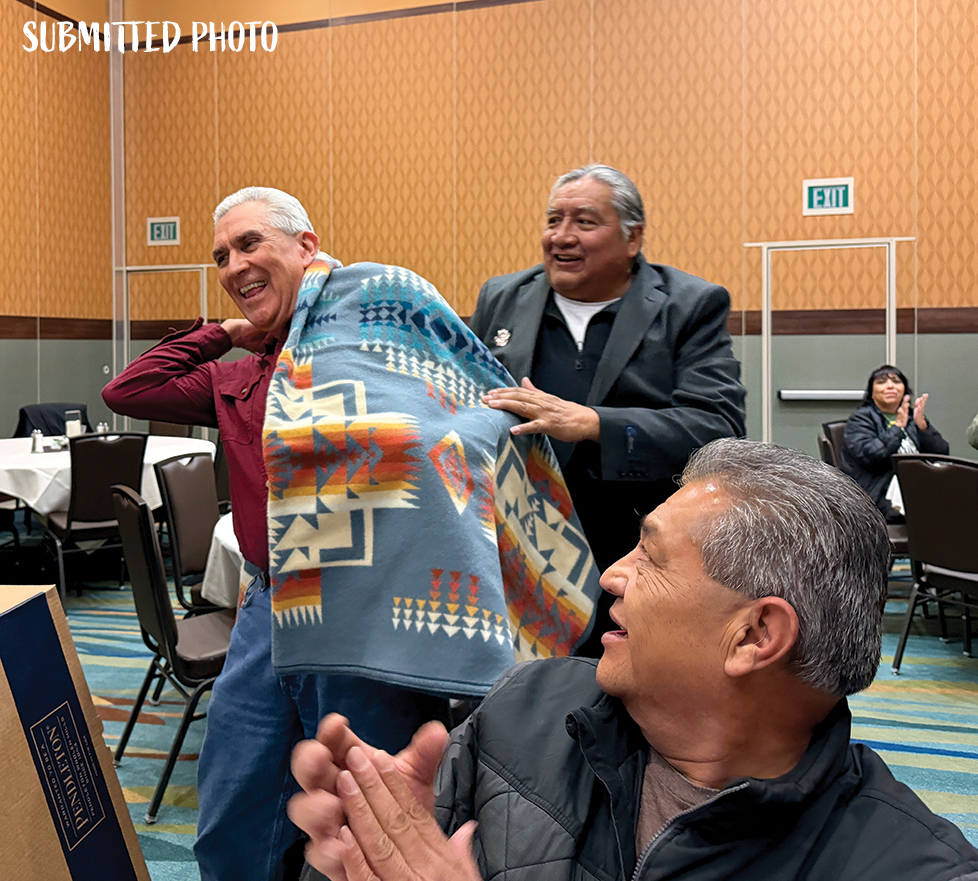Hal Hayball retires from Sho-Ban Tribes as GIS programmer

FHBC Chairman Lee Juan Tendoy puts Pendleton blanket on Hal Hayball.
By LORI ANN EDMO
Sho-Ban News
FORT HALL — Hal Hayball retired from the Shoshone-Bannock Tribes Office of Emergency Management as GIS programmer after 33 years of service to the Tribes.
Fort Hall Business Council Chairman Lee Juan Tendoy placed a Pendleton blanket on Hal in appreciation of his work at a November 15 luncheon in his honor the Tribal Office of Emergency Management sponsored. He also received an embroidered hat from the Tribes Department of Energy program, along with a plaque. Others gave cards and well wishes.
He began working with Tribal Fisheries in 1991 until 1994 according to a TOEM press release. He then transitioned to a contractor role with NASA’s Cultural Resource Program (CRO), working to secure free imaging resources for Indigenous tribes. In 2001, Hal returned to his roots as a GIS programmer, assisting the Tribes with mapping and data under the direction of the late Willie Preacher who was the DOE director at the time.
In 2013, Hal shifted to Emergency Management & Response (EMR), working with Wes Jones. Together, they had key responsibilities in the Emergency Planning Zone (EPZ) and later joined the Tribal Office of Emergency Management (TOEM). His contributions during the pandemic were particularly impactful, as he coordinated testing efforts in the district lodges with the National Guard and developed Incident Action Plans to keep the community safe.
He has a passion for music and as a teenager was the lead singer and bass player for a band called “Dead Ringer” the name shortened to “Ringer” upon learning a band in England had the same name. At 16, he navigated the challenges of performing underage in bars and was allowed to stay 20 feet from the stage. He moved to Seattle when he was 18 graduating from Edmonds College with an associate’s degree in electronic technology. He also pursued his music on the side.
Hal met his wife Lori in the Bay Area, and they have a daughter Amanda who was born in 1995. They also have a granddaughter Mia who is now eight years old.
A highlight of his work is the Tribes addressing system that began in 2013 when he went out and knocked on doors throughout the Fort Hall Reservation. He noted there was resistance from Power County. It took a couple of years to get the model going and took a lot longer to get out in the real public. “It’s a good thing we did it because everything got easier and it made a difference in public perception,” Hayball said.
He appreciated the Tribes Land Use Department and Department of Energy (DOE) to allow him to study GIS in his office. He also did work for other tribal departments such as Fish and Game and the Language and Culture Preservation Department. He did case maps for Fish and Game back when the maps were created from GPS points judges appreciated, they weren’t being lied to.
For now, Hal said he’s going to take care of the field next to his house that he’s neglected all this time and get a tractor. He decided to retire because his accountant advised after October 18 there was no need to work anymore. “I’m going to try it and see how it works out – I might be back temporary,” he said.
Editor’s note: Feliciana Fulmer contributed to this report from TOEM.





